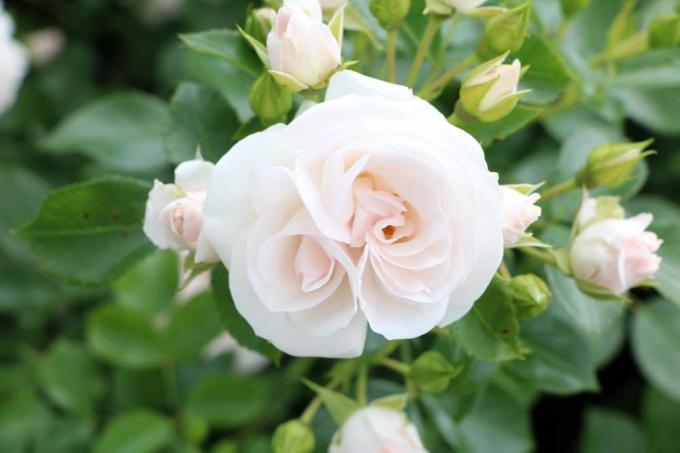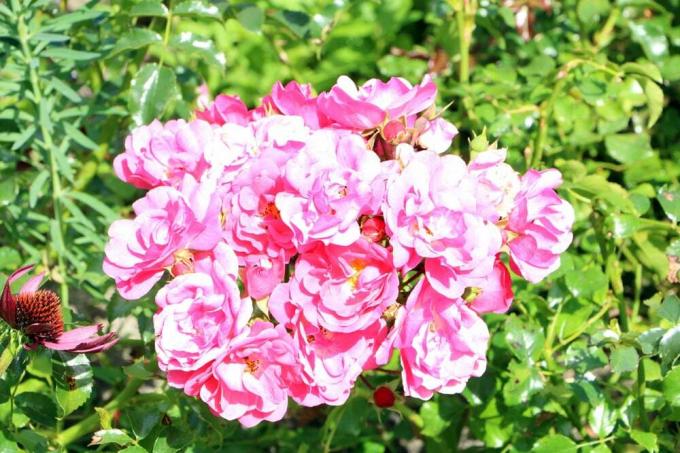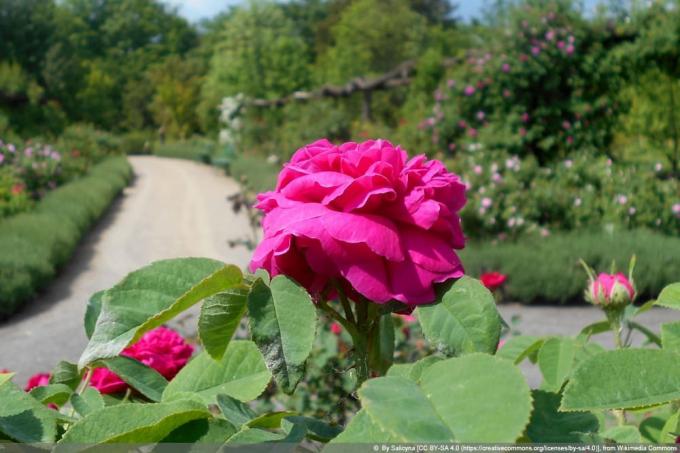

Table of contents
- Location
- Floor
- planting
- planting distance
- layout
- perennials
- layout
Roses are considered little divas by many hobby gardeners. That's why you prefer to keep your hands off it. Roses in the garden are not such a big challenge. If you plan a rose bed correctly in advance and pay attention to the basic things when caring for it, you have no more work with them than with other garden flowers. And he gets a true queen to hold court with him.
Location
The most important point to successfully cultivating roses in the garden is the right location. Sure, location is key to any plant. In the case of Rosen, however, he plays an even greater role. Anyone who is thinking of creating a bed of roses should therefore check carefully what alternative locations their garden offers them. Basically, roses love the sun and need a lot of light. A location that is as sunny as possible is therefore a must. At the same time, however, it must also be protected from the wind, otherwise the fragile leaves of the flowers will be damaged. When planning, it is also important to take into account that you also want to see your roses and enjoy their scent. A more or less hidden bed of roses is a waste - even if everything else fits at the location.
Floor
The soil is almost as important as the location for a rose bed. Something like the golden mean must be found here. Roses do not get along with soil that is too firm or too light. Basically, the soil should be loose. A soil mixture that is rich in humus, has some clay and a certain amount of sand is ideal. A high proportion of clay in the soil means an enormous burden for the plants from the outset, since their roots then get far too little air. As a rule, they cannot thrive there. If the soil is too sandy, i.e. too light, it is best to enrich it with
- some clay
- compost
- rock flour
- and possibly also smaller stones.
If the structure or type of soil is not suitable, but this is the perfect location for a rose bed, you should think about changing the soil. It is best to replace the existing soil with special rose soil from the garden trade. However, such a procedure only makes sense for relatively small beds, as otherwise the costs can quickly get out of hand.
planting
A rule of thumb: The best time to plant roses is autumn - specifically from the beginning of October to the end of November. It is best to use so-called bare-root roses, which are also readily available for purchase at this time. If everything is done correctly when planting, the roots usually survive permanent frosts during the winter and then sprout really well in the spring. In principle, you could also plant roses in the spring, but they usually lag behind the autumn roses in their development. When planting, the following aspects must be taken into account:
- First loosen the soil with a rake
- dig a sufficiently deep planting hole, the roots must not be bent or compressed
- the grafting point of the rose must be below the surface of the earth
- Fill the hole with soil and press lightly, but under no circumstances tread down
- water heavily

If you want to use container roses instead of bare-root roses, you basically do the same thing. However, the excavated planting hole should be about twice the size of the rose planter.
A notice:
Never plant roses in soil that has previously contained a rose. If you are forced to do this, the soil must be replaced over a large area.
planting distance
Usually several roses are planted in one bed. So that there are no problems later, it is essential to ensure that there is sufficient distance between the individual plants. The distances differ from species to species. from variety to variety:
- precious or Bed roses: planting distance 40 to 50 cm
- Shrub and climbing roses: 1 to 1.5 m
- ground cover roses: 50 to 80 cm
- Miniature roses: 30 cm
Sufficient planting distances are important so that the individual plants can develop well and do not get in each other's way. It is therefore ideal to include them in the planning of the rose bed.
layout
A rose bed in the garden can be wonderfully staged. Of course, the most important thing is the combination with other plants or stones. With the right companion plants, the natural beauty of the roses can be emphasized once again. Since roses are bare to a not inconsiderable extent, the plants can be used to conceal these areas. Above all, however, they ensure that diseases and pests can spread less easily than in pure rose beds. In addition to the optical function, the companion plants in the rose bed also have a protective function. Incidentally, the immediate surroundings of the bed should also be taken into account. Boxwood and silver leaf, for example, are perfect for framing the bed.
perennials
Typically, small bedding and shrub roses are combined with perennials. The phlox and delphinium should be mentioned here in particular. Not forgetting that lavender has proven to be a more ideal companion for roses in many ways. If you decide on a combination with one or more of these plants, you also have to pay attention to the planting distances. Both types of plants, roses and perennials, need enough space to develop. It's best to be a little more generous here. It should also be clear that the perennials used as companion plants should also have similar requirements in terms of location and soil conditions. This is of course the case with phlox, delphinium and lavender
layout
When designing a rose bed in your own garden, there are hardly any limits to creativity. You can have fun there to your heart's content. It is important, however, that it should always be about staging the roses. You have to be the center of attention and not let yourself be stolen from the spotlight. Natural stones, among other things, are therefore recommended for the design. On the one hand, they appear imposing enough to provide special visual stimuli, but on the other hand they do not push themselves into the foreground. Especially in so-called natural gardens, stones can be something like the perfect partner in or on the bed of roses.
 garden editorial
garden editorial I write about everything that interests me in my garden.
Learn more about types of roses

Pruning wild roses: 6 tips for trimming wild roses
Wild roses should not be missing in any natural garden. They are easy to care for and bloom on two-year-old wood. The delicate blossoms and autumnal rosehips enchant the garden well into winter. To maintain their beauty, however, some maintenance is necessary.

18 historical roses with picture | Varieties of roses for the home garden
Creating a rose garden is not as easy as you might think. The gardener often only becomes aware of the variety of different flower colors on the market when the purchase decision is imminent. So that the selection does not have to be made spontaneously and that it takes into account both the appearance and the location requirements can be optimally adapted to the circumstances of his garden, he will find an overview of 18 historical ones here varieties of roses.

Moss rose (Rosa centifolia var. muscosa): care from A to Z
The moss rose (Rosa centifolia var. Muscosa) is a profusely flowering old rose variety that resulted from a bud mutation. The special thing about her is the green to brownish moss on the buds, sepals and flower stalks and their sweet, slightly resinous scent.

Making roses winter-proof: fleece, bark mulch & Co | Ideal time
Roses depend on good winter protection so that the royal blooms can be repeated next year. The focus is on specific precautions for the crown, trunk and roots, tailored to the respective rose type. This guide gives a practical explanation of when and how to best winterize your roses.

Tub roses: rose care in the pot | Repot roses properly
In the summer months, the balcony and terrace can be embellished with blooming roses, as these flowers can also be planted in tubs. However, due to the deep roots, there are some important factors to consider when choosing the planter, location, care and repotting.

Rose planting time: when is the best time to plant roses?
Roses have the potential to spark a passion for collecting. Each strain is different, be it flower shape or color. With these noble flowers, there is never a dull moment in the garden. When is the best time to plant new roses?



